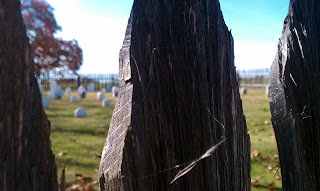The first spur we followed off the main trail was to Skylight Cave, shown below. It was very reminiscent of a scene from Temple of Doom, in case you can't tell from the picture. And in the second picture, the dark little dot on the cave ceiling is a bat. I thought it was cool to be right next to a sleeping bat.
Gibson Gap provided an ideal campsite for us; there were no other people around and we had plenty of flat space to set up camp. It was a great and relaxing site.
Our second day was split up into two main legs: from Gibson Gap to Hensley Settlement, and from Hensley to the White Rocks. On our way to Hensley Settlement, we shot off the trail to find water to replenish our dwindling supply. It was a Godsend to find a stream that was not dried up like the one near our first campsite. Below you can see Johnathan and Trenton pumping water through the purifiers they brought, and me looking thirsty.
Hensley Settlement was a grouping of farms and houses, along with a small schoolhouse. We ate lunch here, including apples picked off the trees, and checked out some of the wood and stone buildings. We thought they were a lot older than they actually are. Some of them were restored or rebuilt in the late 1960s to reflect the original construction. Below is an old furrow (or whatever it might be called), and my attempt at an artsy photo of a graveyard there at the settlement.


On our way from Hensley to the White Rocks campsite, we followed another spur down, down to Sand Cave. This cave was more impressive than Skylight Cave -- there is an acre and a half of sand sloping up from the floor of the valley to an enormous rock overhang that forms the cave.
We covered a little more ground and then made camp near White Rocks. On the way we saw a doe ahead, and tried to be really quiet as we approached, but we found that she was not alarmed by our presence at all! We got 15-20 feet away from her, with her staring right at us, and another doe walked casually up and joined her!
White Rocks campsite was a little more crowded. We saw one or two people at most during the day as we hiked in, but there were three groups that had made camp there before us. They likely started from the other end of the trail, where we would finish the next morning. We found the flattest remaining spot that we could, which was tight between some trees. And we made the first hot food we could (chicken-flavored creamy rice for me), since at this point we had water to cook with.
Sunday morning Trenton read to us from Proverbs after we had packed up, and we headed out on the final leg. We had an immediate detour planned -- the White Rocks overlook, which was about a half mile from camp. This was the highlight of the trip. The view was beautiful. May the applicable cliche be here noted: the pictures don't do it justice.
Here at the overlook, the climax of the story I'd been ruminating on for much of the weekend appeared. I looked forward to this trip as all people do. It was a great opportunity to get away, to remove distractions, to unencumber from the stream of noise that fills most other days. A temptation for me was to try to completely capture the experience through photos and through looking into every nook that I could, counting steps and granola bars and tenths of miles until I had preserved it in my mind to carry with me out of the gap.
What came to mind was (as usual) from Orthodoxy by G.K. Chesterton. It's tempting to quote the whole chapter to give context to the point he made, but this will suffice:
"...Imagination does not breed insanity. Exactly what does breed insanity is reason. Poets do not go mad; but chess-players do. Mathematicians go mad, and cashiers; but creative artists very seldom. I am not, as will be seen, in any sense attacking logic: I only say that this danger does lie in logic, not in imagination... The general fact is simple. Poetry is sane because it floats easily in an infinite sea; reason seeks to cross the infinite sea, and so make it finite... To accept everything is an exercise, to understand everything a strain. The poet only desires exaltation and expansion, a world to stretch himself in. The poet only asks to get his head into the heavens. It is the logician who seeks to get the heavens into his head. And it is his head that splits."
By luck I ran across another cool tidbit when searching for the Chesterton quote. "Sagarmatha" is the old Nepali name for Mount Everest, which literally means "head in the heavens". White Rocks was no Mount Everest, but the name still fits.












